Remember that song about the old lady who swallowed a fly (perhaps she’ll die), and then swallowed a spider to catch the fly, then swallowed a bird to catch the spider? By the end of the song, she’d swallowed a whole horse (she died, of course) trying to solve a problem that had been created while trying to solve another problem. This cautionary tale of unintended consequences has followed us since childhood. Though it is exaggerated (and therefore funny — but really, how does one swallow a horse?), its lesson is more pertinent than one might think: be wary of the war of escalation that may arise when you solve problems without considering the consequences of your solutions.
Sometimes the solution to a problem can inadvertently create an even bigger problem, and Macquarie Island is a case in point. The following will demonstrate how the Cause Mapping approach to root cause analysis can clarify complex issues and aid in the selection of solutions that solve the original problem without creating others.
A Short History of Macquarie Island
Macquarie Island, located about halfway between Australia and Antarctica, is a UNESCO World Heritage site. A spectacular breeding ground for aquatic wildlife, especially elephant seals and royal penguins, it was discovered by accident in 1810, uninhabited. Sealers soon took interest in its abundant supply of blubbery animals, and though they tended to view the island as “the most wretched place of voluntary and slavish exilium that can possibly be conceived,” the money to be made from its natural resources prompted repeat visits. As The Asiatic Journal and Monthly Register for British India and Its Dependencies put it in 1823 source put it, “nothing could warrant any civilized creature living on such a spot, were it not for the certainty of industry being handsomely rewarded.”
The Island’s unique history has also made it classic study of what happens when an ecological balance is disrupted. With the arrival of the Europeans, the island’s seals and penguins, which had until then lived without natural predators, were hunted for their blubber and fur; by 1919 they were near extinct. These hunters did not come empty-handed, however: aboard their ships were stowaways in the form of rats and mice, who prospered on the island due to the lack of predators. Though their presence to the island was entirely unintentional, the trouble the unchecked rodent population caused on the island (eating human food stores) led to the deliberate introduction of cats, brought to protect the human food supply from all of the rats. Then, in 1870, sealers had another idea: why not bring rabbits to the island to breed for food?
The rate at which rabbits breed, of course…well, you can imagine what happened. The rabbits bred like rabbits. The cats must have been thrilled to be on an island with so many rodents, but feral cats don’t tend to understand instructions very clearly, and it didn’t take long for them to set their sights on the native seabird population. Now, the thing about ecosystems that develop for many many years without interference is that animals without predators do not evolve protections against predators. When the feral cats were introduced, they did not meet with much resistance from their avian victims, and thus amassed a devastating 60,000 seabird deaths per year. Beginning in 1985, therefore, efforts began to get rid of the cats. By 2000, with the last of the feral cats culled, the seabird numbers came back up. But then there were the rabbits…
With fewer predatory cats, the rabbit population exploded. The rabbits consumed an estimated 40% of the island’s vegetation, creating an ecosystem crisis larger than the cat problem that had itself been intended to solve the rodent problem.
Solutions, then, can produce both desired outcomes and undesirable side effects. They need to be selected carefully, because resolving a problem with a solution that creates more problems is inefficient to say the least.
Using Root Cause Analysis to Select Solutions
Root cause analysis serves to understand the causes of any given issue thoroughly and completely, to prevent the selection of problem-creating solutions. Most problems in an organization involve several people from different groups, each with their own perspective regarding the problem in question, each of which only tells part of the story. A comprehensive root cause analysis results in a complete picture of an issue, with all of its causes plain for all to see. The visual representation of an issue and its various causes is called a Cause Map.
Understanding the causes of a problem and the potential consequences of its solutions should be part of the problem solving process in every organization. The level of detail furnished by root cause analysis within each individual problem provides the insight necessary to improve overall operations and to select solutions that solve problems once and for all, rather than creating more of them.
Root Cause Analysis Problem Outline
This is a simple outline of the original problem. When performing root cause analysis of any issue, it is important to define the problem as specifically as possible by capturing the issue, the time and differences, the physical location, and in this case, the work being done. From the outline below, we can see that we will be analyzing the problem of birds becoming endangered in January 2008, with the change being that non-native species had been introduced to the island. The physical location is Macquarie Island, in the South Pacific, and the work being done was a conservation program for the island.
There are no personnel safety issues (the birds don’t count as personnel), but the environmental goals were negatively impacted because of the loss of native seabirds.

Root Cause Analysis Cause Map (2-Whys)
The Cause Map that we will be creating can be of varying levels of complexity, depending on how many questions we ask. The basic Cause Map below reflects asking two “why” questions.
The root cause analysis begins by listing the adversely impacted environmental goal, which was affected by the reduction in the seabird population. Asking why the seabird population was reduced, we note that cats ate the birds, and capture this cause-effect relationship to the right of the goal.

Root Cause Analysis Cause Map (5-Whys)
If we ask more questions, however, we get more elements to add to the map. There are three reasons that the cats ate, and therefore reduced the population of, the seabirds: the seabirds were native to the island, the cats are predatory animals, and the (predatory) cats were on the island. All three elements are required to produce the result in which the cats killed the seabirds.
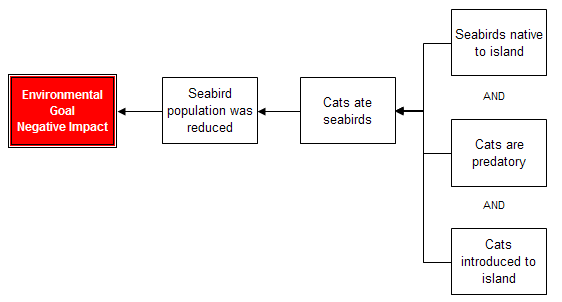
Solutions in root cause analysis are specific actions that control causes. An obvious solution to the problem of the cats eating the seabirds is to remove the cats. On the cause map, this solution is placed directly on the cause that it controls.
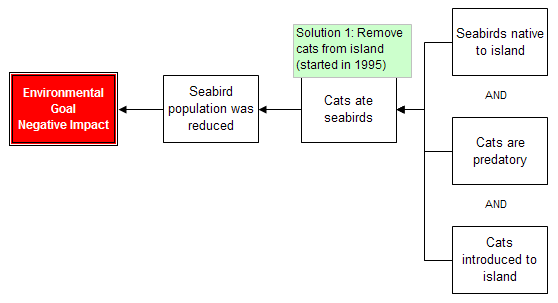
Now, clearly, removing cats from the island solves the problem of having cats on the island. However, this solution itself becomes a cause of another effect: fewer predators on the island to check the rabbit and other rodent population. The effects of the solution “remove cats” can likewise be diagrammed on the Cause Map, as shown below.
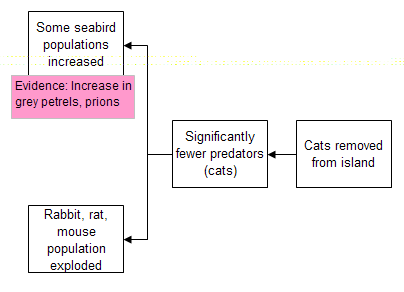
Root Cause Analysis-Another Cause Map (2-Whys)
Having fewer predators hanging about increased the population of seabirds that served in large part as their prey, and this was certainly a positive development in relation to the environmental goal. On the other hand, fewer predators also significantly increased the population of rabbits and rodents. This caused different problems.
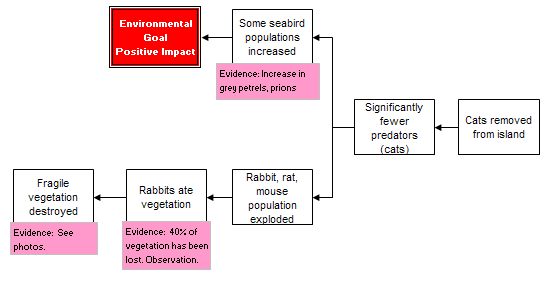
The rabbits consumed a massive amount of vegetation, giving rise to extreme erosion and insufficient cover for the seabirds. Thus, the solution to the serious threat to the seabird population created another threat to the environmental goal. We can trace both the positive and the negative effects of removing the cats on the environmental goal on the Cause Map, resulting in a clear visual depiction of cause and effect in this case.

The original problem outline now changes to reflect the impact on the ecosystem. We add the loss of vegetation on the island as a problem, and now we have a new goal that was affected: the material and labor goal was impacted by the remediation required to restore the ecosystem, to the tune of over 16 million dollars.

The solution now becomes removing the rabbits, rats, and mice–the foreign animal species that wreaked havoc on an environment that was not equipped to keep them in check. Had the cats and rabbits been removed at the same time, in fact, this issue would have been avoided.
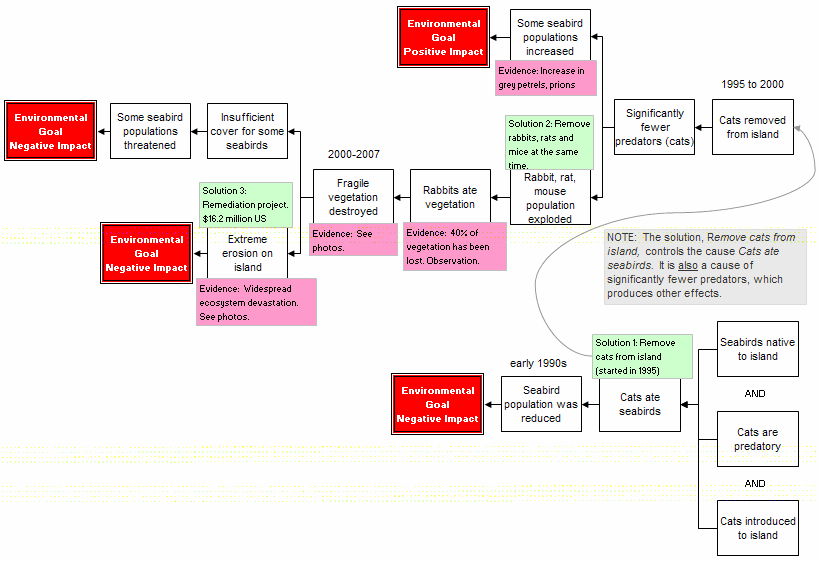
Aftermath
Efforts to protect Macquarie Island began long before the full impact of introducing cats and rabbits to the island was understood. The first foreign species to be introduced to its shores had been man, and his hunting alone was enough to disturb the ecological balance. With it seals and penguins hunted to near-extinction, the island was declared a wildlife sanctuary under the Tasmanian Animals and Birds Protection Act in 1933, and in 1972 it became a state reserve. More recently, it was named a UNESCO World Heritage Site for its unique geological features in 1997.
The Tasmanian government began efforts to eradicate all non-native species from the island beginning in 2010, through poison baiting and hunting. This is not an easy project, as it will only work if they manage to eliminate all unwanted animals without significantly damaging the wildlife they wish to preserve. As of Spring of 2013, the project is ongoing.
Root Cause Analysis
Root cause analysis focuses on the cause-effect principle and can be applied consistently to day-to-day issues as well as catastrophic, high risk issues. Focusing on the basics of the cause-and-effect principle make the cause mapping approach to root cause analysis a simple and effective method for determining potential solutions and weighing them in the context of an acceptable level of risk. In the case of the incident on Macquarie Island, root cause analysis allowed us to identify a solution that effectively eliminates the original problem without creating others.
Bring Cause Mapping® Root Cause Analysis training to your site
Schedule a workshop at your location to train your team on how to lead, facilitate, and participate in a root cause analysis investigation.
